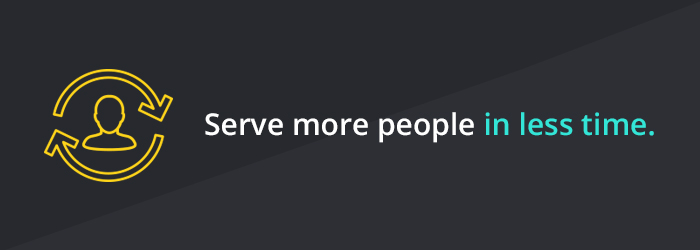
How to Improve Queuing in the Public Sector: 3 Keys to Serving More People in Less Time
When planning a trip to the post office, courthouse, DMV, or similar public service organization, people expect to have to wait. How long they wait and the quality of the waiting experience, however, can impact their satisfaction tremendously and cause ripple effects of outward frustration, a stressful public environment, and reduced staff morale.
Research shows a strong correlation between wait times and customer satisfaction. By tending to the length of wait times, or even perceived wait times, managers can improve customer satisfaction while cultivating a more positive service environment overall. A more efficient queue is a sure and fast way to improve multiple performance factors while creating the best experience possible for everyone.
To make a difference, check out these three keys to improve public sector queues:
1. Direct customers to available personnel.
The most efficient service can happen when customers are quickly and clearly able to connect with the ‘next’ agent as soon as they are available, without delay or confusion. If there is uncertainty or confusion and a customer’s attention must remain wholly on the wait or when their turn will be, the wait can seem like a long one, even if it’s actually not. With clear communication and direction, customers can relax knowing exactly when their turn will be, and with whom. Their perceived wait time is less.
Simple solutions like directional signage or a digital call forward system can support customers to be ready at the right time and place. This supports a better experience and more efficient service for everyone.
2. Enable advanced pre-scheduling or appointment setting.
Another way to enhance efficiency and reduce wait times is with pre-scheduling or appointment setting technology. By matching up an available service agent with customers at set times, customers get to maintain control over their time, calling the shots and creating positive, personalized experiences — scenarios likely to generate a high level of satisfaction.
Today’s queuing technologies include scheduling features as well as mobile integrations where a customer can be kept up to date on actual wait times and any changes that impact their appointment, even via text on the go.
3. Manage traffic flow with real-time and historical data.
Real-time footfall analytics, as well as historical trend tracking of traffic patterns, can help inform how to best serve customers during busy times. Armed with quality information, managers can better predict customer arrivals and position staff appropriately to service customers in the best way possible. Information is power when it comes to managing a queue with efficiency.
While these ideas can help you to serve more people in less time, they can also boost staff morale by making it easier and more efficient to serve customers and therefore reduce customer complaints.
SUBSCRIBE
Subscribe to stay up-to-date with new products, resources information and news.
RECENT RESOURCES
Theft at the Register: How Strategic Queue Design Protects Profits
ViewRapid Deployment Crowd Control: JetTrac Portable Barriers For The Biggest Spaces
View4 Psychological Reasons Your Customers Hate Waiting In Line
ViewFrom Bleachers To Bookstores: 4 Campus Crowd Control Solutions
View








